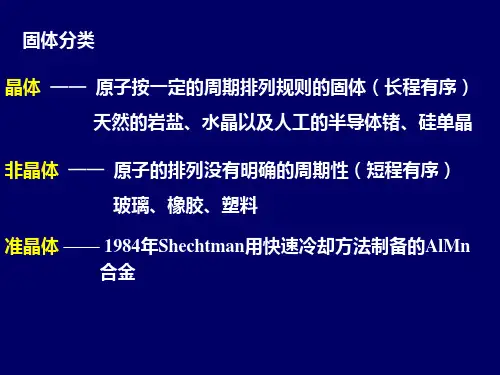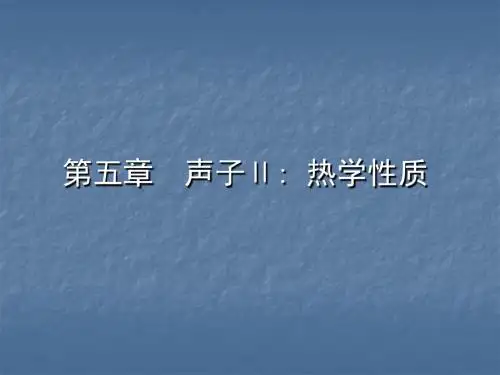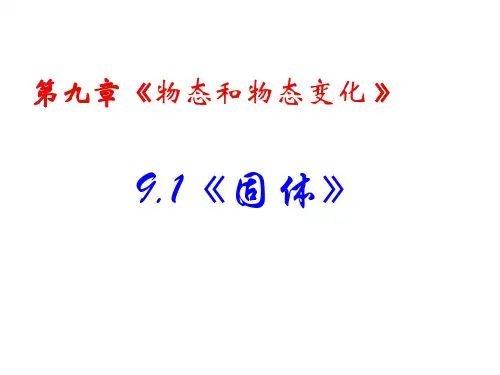- 1、下载文档前请自行甄别文档内容的完整性,平台不提供额外的编辑、内容补充、找答案等附加服务。
- 2、"仅部分预览"的文档,不可在线预览部分如存在完整性等问题,可反馈申请退款(可完整预览的文档不适用该条件!)。
- 3、如文档侵犯您的权益,请联系客服反馈,我们会尽快为您处理(人工客服工作时间:9:00-18:30)。
over all phonon modes:
U
UK,p
nK, p K, p
Kp
Kp
where <nK,p> is the thermal equilibrium occupancy of phonons of wavevector K and polarization p, and is
given by the Planck distribution function:
The heat capacity:
CV
U T
9
Nk
B
T
3
xD dx
0
x4ex (ex 1)2
Discussion: 1. Dulong-Petit law
At high temperature T >> ,
i.e. xD << 1
ex 1 x
CV
9
Nk
B
T
3
xD dx
0
x4ex (ex 1)2
2 2v33
xD dx x3 0 ex 1
where x / kBT , andห้องสมุดไป่ตู้xD D / kBT / T
The
Debye
temperature
v kB
6 2
V
N
1/ 3
Then the total thermal energy is
U
9
Nk
BT
T
3
xD dx
0
x3 ex 1
Density of states in one dimension
Consider vibrations of a 1d line of length L carrying N+1 particles at separation a.
There are two equivalent methods for enumerating the number of the mode. Method 1: fixed boundary conditions Method 2: periodic boundary conditions
9
Nk
B
T
3
xD dx
0
x4 x2
3NkB
At high temperature the heat capacity approaches
to the classical value of 3NkB from the Dulong-
Petit law.
2. Debye T3 law
At very low temperature T << ,
0
dx
x3 ex 1
4
15
Thus
U
3 4 NkB 5 3
T
4
Then
CV
12 4 Nk 5 3
B
T3
T3
i.e. xD
Debye T3 law matches
quite good experimental results for isolators at sufficiently low temperature.
The cutoff wavevector KD:KD (6 2 N /V )1/3
There is NO wavevector larger than KD in Debye
model.
The thermal energy for each polarization:
U p d D(p ) n(p ) p
Chapter 5 Phonons II. Thermal
properties
Key points:
• Phonon heat capacity
• Density of state
• Debye model
• Thermal conductivity
Phonon heat capacity
phonon gas
The average excitation quantum number of an
oscillator is
sNs s exp( s / )
n
s
s
Ns exp( s / )
s
s
N
Ns
s
The total number and the total energy inside the square are same as those of the oscillators.
UK,p
nK, p
K , p
K , p exp(K,p / ) 1
The total energy in thermal equilibrium is
U
K
UK,p
p
K
K , p p exp(K, p / ) 1
Suppose that the crystal has Dp( )d modes of a given polarization p in the frequency range
vs K in selected crystal directions by
inelastic neutron scattering and then to make a theoretical analytic fit to give the dispersion relation in general direction, from
constant for
each
polarization type. i.e. vK
The density of states:
D() (VK2 / 2 2 )(dK / d)
V ( / v)2 1 V3 2 2 v 2 2v3
The cutoff frequency D: D (6 2v3N /V )1/3
Method 2: periodic boundary conditions
(N+1)
u(sa) u(sa L)
s=1
N
2
us u(0) exp[ i(sKa K, pt)],
with
K 0, 2 , 4π , 6π , ..., Nπ .
LLL
L
N1
3
4
..... .
. .....
There are three polarizations p for each value of K: 2 transverse modes, 1 longitudinal mode.
The number of allowed K values in a single branch
for the 1st Brillouin zone equals to the number of the primitive cells. The number of modes equals to the total degrees of the freedom.
nK , p
1
exp( /
)
1
Planck distribution Consider a set of identical harmonic oscillators in thermal equilibrium.
Nn1 / Nn exp( / kBT ) exp( / )
then
Nn N0 exp( n / )
i+1
i1
i
ui a
For periodic boundary conditions the number of
modes per unit range of K is L/2 for /a K /a, and 0 otherwise.
dN / dK L / 2 , for a / K a /
Density of states in three dimensions
Apply periodic boundary conditions over N3
primitive
cells
within
a
cube
of
side
L.
u u(0) exp[i(K r K,pt)]
exp[i(Kx x K y y Kz z)] exp{i[Kx (x L) K y ( y L) Kz (z L)]}
to + d .
Then
the
energy U
p
is
d
Dp
()
K , exp(K, p
p
/
)
1
Dp () dN p / d
The lattice heat capacity is
Clat
U T V
kB
p
d
Dp
()
x2 exp x (exp x 1)2
where x / kBT
The density of the state:
D()d L dK d L d d d / dK
Density of states in two dimensions
Within the circle of area K2 the smoothed number of allowed points is K2(L/2)2.
K , 2 , 3 , ... (N 1) .
LL L
L
The number of mode is equal to the number of
particles allowed to move. There is one mode for
ach interval K = /L, so that the number of modes per unit range of K is L/ for K /a, and 0 for K /a.






